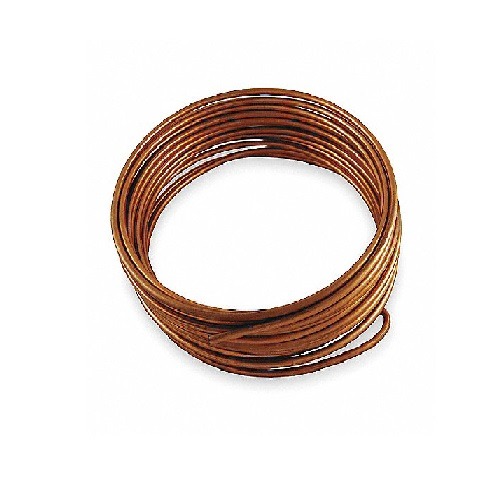The capillary tube for a 1/3 HP refrigerator depends on the type of refrigerant gas used and the application’s temperature, both in the evaporator and condenser.
ATTENTION: At the end of this article, you can access a FREE course on capillary tubes for refrigerant gases.
The capillary tube for a refrigerator can regulate the passage of refrigerant because it has a very small diameter, which restricts the flow of the fluid, and it is also relatively long, contributing to the pressure loss of the flow that passes through it.
1/3 HP Refrigerator Capillary Tube:
The following video prepared by CST explains some recommendations to take into account before definitively selecting the size of a capillary tube.
Capillary for 1/3 hp compressor in refrigeration:
| Applications according to Temperature | evaporation temperature _ | Condensing temperature _ |
| LBP Low Pressure | -23,3 °C -10°F | 54,4 °C 130°F |
| MBP Medium Pressure | -6,7 °C 20°F | 54,4 °C 130°F |
| HBP High Pressure | 7,2 °C 45°F | 54,4 °C 130°F |
Capillary for 1/3 motor for cooling:
Before selecting the capillary for 1/3 HP motor you should know:
- Capillary tubes depend on both their length and diameter to determine their overall restriction.
- A percentage change in diameter can affect the flow more significantly than an equivalent change in length.
- The restriction can also be adjusted by either lengthening or shortening the tube.
- As a general rule, the longer the tube, the slower the flow. However, there comes a point where excessively increasing the tube’s length to enhance restriction and reduce flow becomes inefficient and often futile.
- Conversely, as the tube’s length decreases, the flow gradually increases until it reaches a critical point, where the flow rate starts to increase more rapidly with each further reduction in length. If the length is further reduced, it reaches a stage where even minor alterations in length result in significant increases in flow.
- At this point, the tube behaves less like a capillary tube and more like an orifice.
- As a practical recommendation, it’s advisable to keep the tube length within a range of no less than 5 feet and no more than 16 feet.
- While exceptions may exist, adhering to this guideline for daily operations will help minimize many potential issues.

What capillary does a 1/3 compressor use with R134a?
| HP Compressor Electric Power | Application | diameter in | Length m |
| 1/3 | LBP | 0.036 | 2.5 |
| 1/3 | HBP | 0.050 | 2.0 |
| 1/3 | MBP | 0.042 | 3.0 |
| 1/3 | HBP | 0.050 | 1.5 |
| 1/3 | MBP | 0.042 | 1.5 |
What capillary does a 1/3 compressor have with R-410A?
HP power | Low Evaporator Temperature -10°F Diameter/ Length | Average Evaporator Temperature 25°F Diameter/ Length | High Evaporator Temperature 45°F Diameter/ Length |
| 1/3 | 0.031 in 38″ | 0.031 in 30″ | 0.042 in 62″ |
Capillaries for 1/3 HP Compressor with R404A:
For an electrical power of 1/3 HP, a cooling capacity close to 1100 Btu/hour is expected with the following dimensions:
| Refrigeration Capacity Diameter/ Capillary Length | Evaporator temperature -10 °F -17.22 C | Temperatura Evaporador 25°F -3.89°C | Temperatura Evaporador 45°F 7°C |
| 1000 Btu/h 250 Kcal/h | 0.031″ – 4½ ft | 0.031″ – 5 ft | 0.031″ – 5 ft |
| 1,250 Btu/h 312 Kcal/h | 0.040″ – 12 ft | 0.040″ – 13 ft | 0.040″ – 13½ ft |
Capillaries for 1/3 HP Compressor with R22
| HP Compressor Power | Application | diameter in | Length m |
| 1/3 | HBP | 0.050 | 2.0 |
| 1/3 | MBP | 0.042 | 3.0 |
R407C Capillary Tube Table:
The following table shows the approximate values of the diameter and length of the capillary, depending on the evaporator temperature, and the power in HP of the compressor.
| HP | Low Temperature Diameter in Length in | Average Temperature Diameter in Length in | High Temperature Diameter in Length in |
| 1/3 | 0.031 30″ | 0.042 96″ | 0.042 47″ |
What is the refrigeration capacity of a 1/3 HP compressor when used with its corresponding capillary?
The refrigeration capacity will depend on the evaporation temperature:
| -35°C | -30°C | -25°C | -20°C | -15°C | -10°C |
| 388,47 BTU /H | 592,99 BTU /H | 830,55 BTU /H | 1108,75 BTU /H | 1435,18 BTU /H | 1817,44 BTU /H |
1/3 HP Compressor Cooling Capacity Chart
With the values in the table, a compressor with a 1/3 HP motor that works at a temperature of -20°C and R134a gas achieves a cooling capacity close to 1108.75 Btu/hour.
HOWEVER, you should be aware that the cooling capacity of the 1/3 HP compressor may be different with varying operating conditions such as:
- Compression Process Type.
- Compressor performance.
- Hertz Frequency Change.
- Compressor motor rpm.
- Temperature of the external area of the condenser.
- Condenser exchanger cooling method (natural or forced)
- Degree of subcooling of the refrigerant gas reached in the condenser.
- Degree of superheating of the refrigerant at the outlet of the evaporator.
The reference for this table are:
- Degree of superheat at the outlet of the evaporator of 5°C
- Subcooling value at the condenser outlet of 5 °C
- 35°C ambient temperature
- Reference refrigerant R134a.
When any of these references vary, then the refrigeration capacity of the 1/3 HP compressor will be different.
